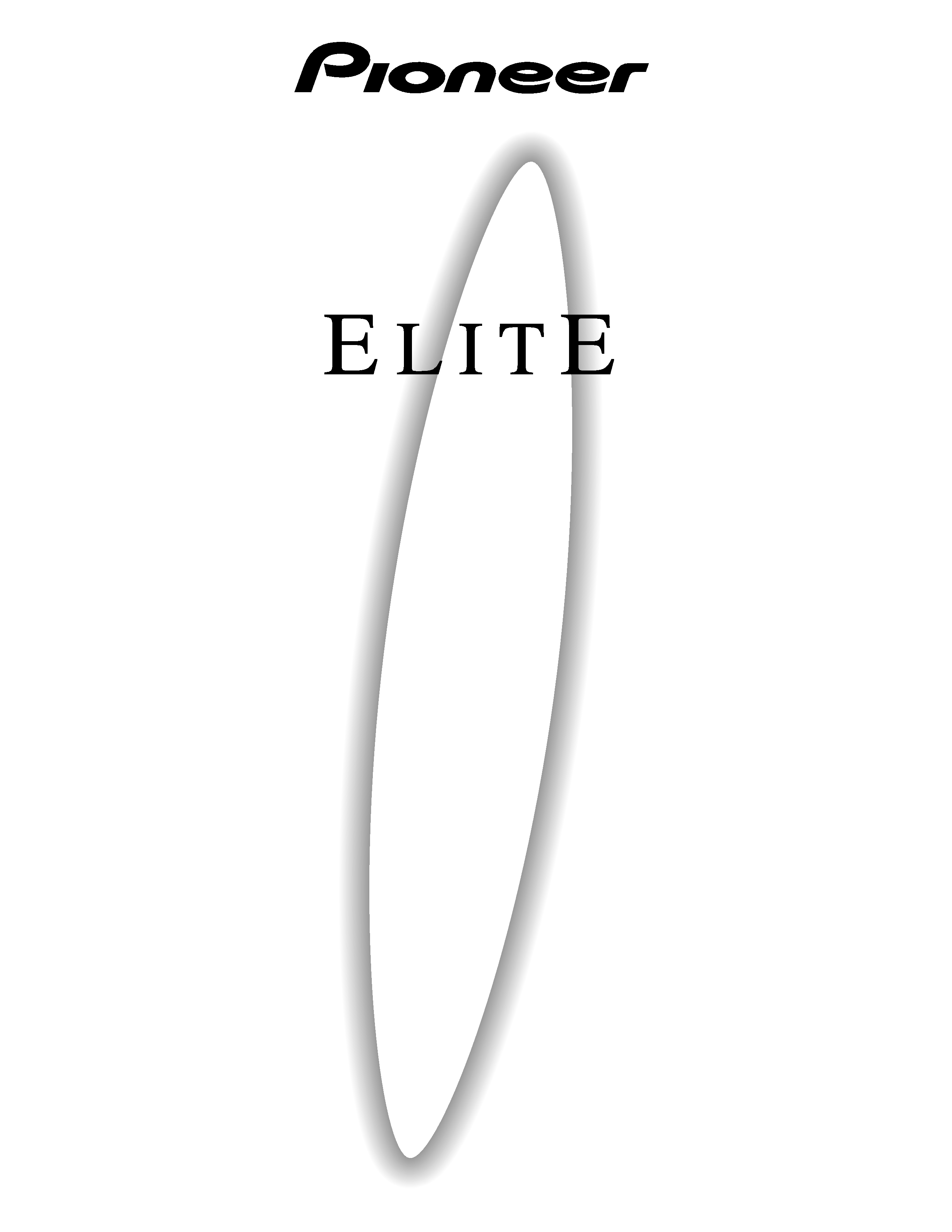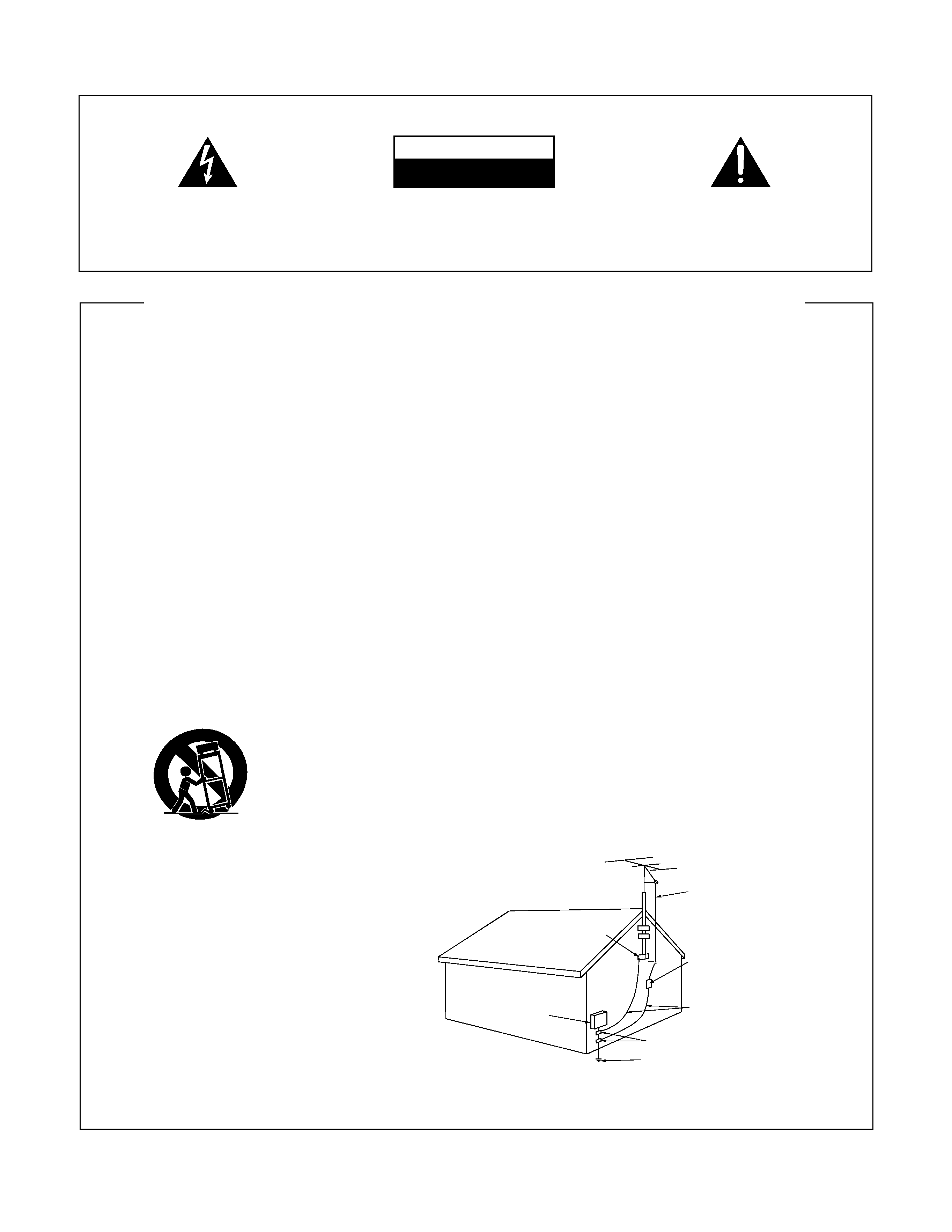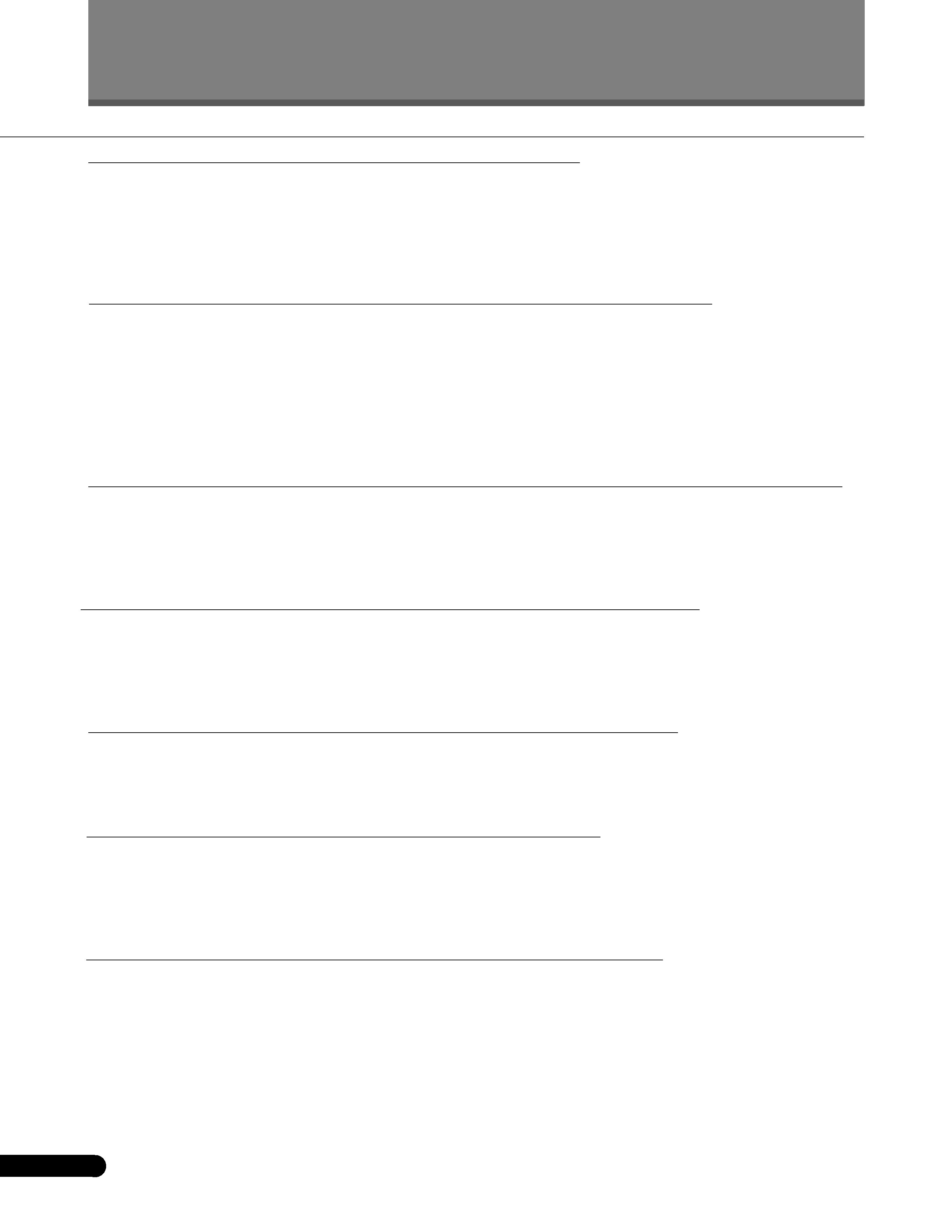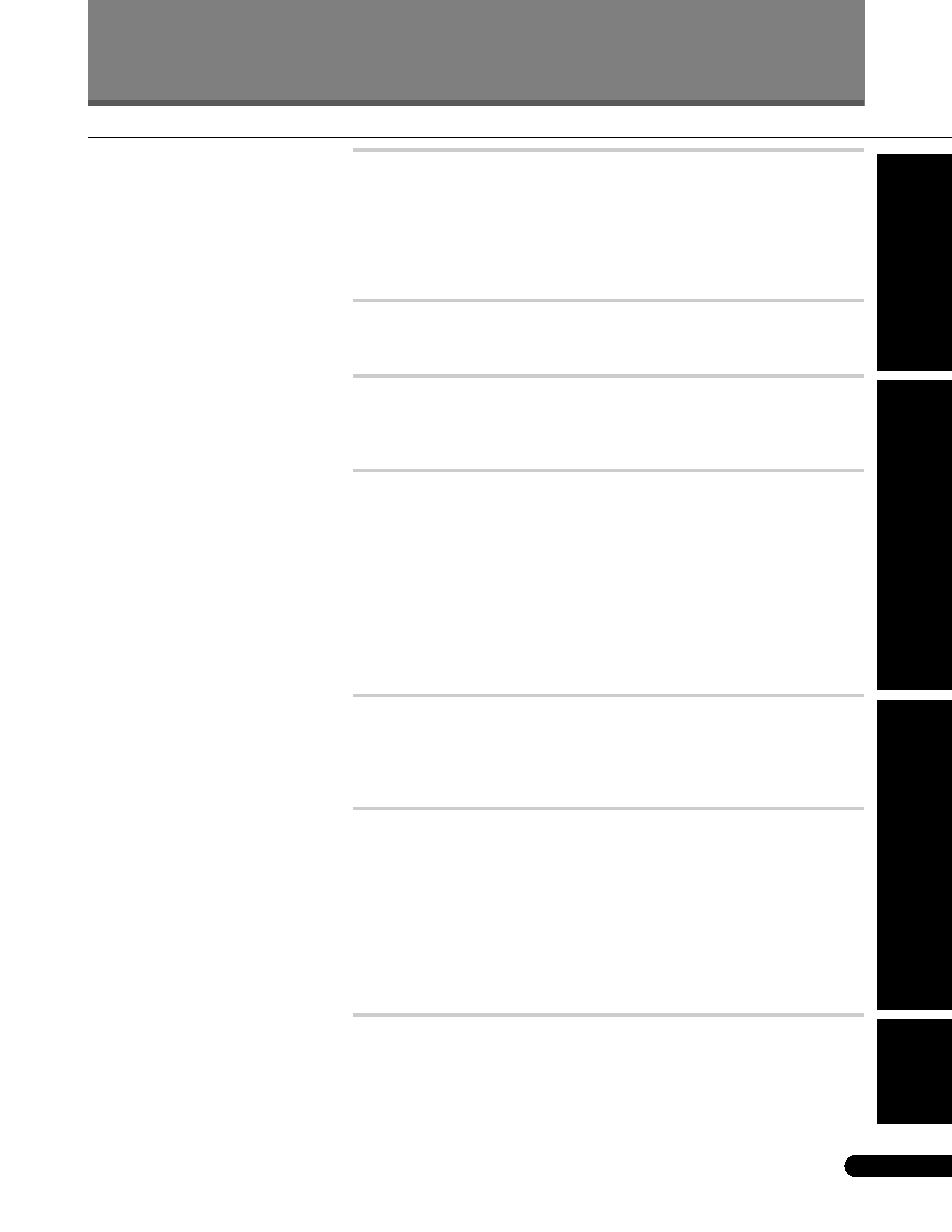
PD-F19
PDR-19RW
Operating Instructions
COMPACT DISC RECORDER

The exclamation point within an equilateral
triangle is intended to alert the user to the presence
of important operating and maintenance
(servicing) instructions in the literature
accompanying the appliance.
IMPORTANT
The lightning flash with arrowhead symbol, within
an equilateral triangle, is intended to alert the
user to the presence of uninsulated "dangerous
voltage" within the product's enclosure that may
be of sufficient magnitude to constitute a risk of
electric shock to persons.
CAUTION:
TO PREVENT THE RISK OF ELECTRIC SHOCK, DO
NOT REMOVE COVER (OR BACK). NO USER-SER-
VICEABLE PARTS INSIDE. REFER SERVICING TO
QUALIFIED SERVICE PERSONNEL.
RISK OF ELECTRIC SHOCK
DO NOT OPEN
CAUTION
READ INSTRUCTIONS -- All the safety and operating
instructions should be read before the product is
operated.
RETAIN INSTRUCTIONS -- The safety and operating
instructions should be retained for future reference.
HEED WARNINGS -- All warnings on the product and
in the operating instructions should be adhered to.
FOLLOW INSTRUCTIONS -- All operating and use
instructions should be followed.
CLEANING -- Unplug this product from the wall outlet
before cleaning. The product should be cleaned only
with a polishing cloth or a soft dry cloth. Never clean
with furniture wax, benzine, insecticides or other
volatile liquids since they may corrode the cabinet.
ATTACHMENTS -- Do not use attachments not
recommended by the product manufacturer as they
may cause hazards.
WATER AND MOISTURE -- Do not use this product
near water -- for example, near a bathtub, wash
bowl, kitchen sink, or laundry tub; in a wet basement;
or near a swimming pool; and the like.
ACCESSORIES -- Do not place this product on an
unstable cart, stand, tripod, bracket, or table. The
product may fall, causing serious injury to a child or
adult, and serious damage to the product. Use only
with a cart, stand, tripod, bracket, or table
recommended by the manufacturer, or sold with
the product. Any mounting of the product should
follow the manufacturer's instructions, and should
use a mounting accessory recommended by the
manufacturer.
CART -- A product and cart combination should be
moved with care. Quick stops, excessive force, and
uneven surfaces may cause the product and cart
combination to overturn.
GROUNDING OR POLARIZATION
¶ If this product is equipped with a polarized alternating
current line plug (a plug having one blade wider than
the other), it will fit into the outlet only one way. This
is a safety feature. If you are unable to insert the plug
fully into the outlet, try reversing the plug. If the plug
should still fail to fit, contact your electrician to
replace your obsolete outlet. Do not defeat the
safety purpose of the polarized plug.
¶ If this product is equipped with a three-wire
grounding type plug, a plug having a third (grounding)
pin, it will only fit into a grounding type power outlet.
This is a safety feature. If you are unable to insert the
plug into the outlet, contact your electrician to
replace your obsolete outlet. Do not defeat the
safety purpose of the grounding type plug.
POWER-CORD PROTECTION -- Power-supply cords
should be routed so that they are not likely to be
walked on or pinched by items placed upon or
against them, paying particular attention to cords at
plugs, convenience receptacles, and the point where
they exit from the product.
OUTDOOR ANTENNA GROUNDING -- If an outside
antenna or cable system is connected to the product,
be sure the antenna or cable system is grounded so
as to provide some protection against voltage surges
and built-up static charges. Article 810 of the National
Electrical Code, ANSI/NFPA 70, provides information
with regard to proper grounding of the mast and
supporting structure, grounding of the lead-in wire
to an antenna discharge unit, size of grounding
conductors, location of antenna-discharge unit,
connection to grounding electrodes, and
requirements for the grounding electrode.
See Figure A.
LIGHTNING -- For added protection for this product
during a lightning storm, or when it is left unattended
and unused for long periods of time, unplug it from
the wall outlet and disconnect the antenna or cable
system. This will prevent damage to the product
due to lightning and power-line surges.
POWER LINES -- An outside antenna system should
not be located in the vicinity of overhead power lines
or other electric light or power circuits, or where it
can fall into such power lines or circuits. When
installing an outside antenna system, extreme care
should be taken to keep from touching such power
lines or circuits as contact with them might be fatal.
OVERLOADING -- Do not overload wall outlets,
extension cords, or integral convenience receptacles
as this can result in a risk of fire or electric shock.
OBJECT AND LIQUID ENTRY -- Never push objects of
any kind into this product through openings as they
may touch dangerous voltage points or short-out
parts that could result in a fire or electric shock.
Never spill liquid of any kind on the product.
SERVICING -- Do not attempt to service this product
yourself as opening or removing covers may expose
you to dangerous voltage or other hazards. Refer all
servicing to qualified service personnel.
DAMAGE REQUIRING SERVICE -- Unplug this product
from the wall outlet and refer servicing to qualified
service personnel under the following conditions:
¶ When the power-supply cord or plug is damaged.
¶ If liquid has been spilled, or objects have fallen into
the product.
¶ If the product has been exposed to rain or water.
¶ If the product does not operate normally by following
the operating instructions. Adjust only those controls
that are covered by the operating instructions as an
improper adjustment of other controls may result in
damage and will often require extensive work by a
qualified technician to restore the product to its
normal operation.
¶ If the product has been dropped or damaged in any
way.
¶ When the product exhibits a distinct change in
performance -- this indicates a need for service.
REPLACEMENT PARTS -- When replacement parts
are required, be sure the service technician has used
replacement parts specified by the manufacturer or
have the same characteristics as the original part.
Unauthorized substitutions may result in fire, electric
shock, or other hazards.
SAFETY CHECK -- Upon completion of any service or
repairs to this product, ask the service technician to
perform safety checks to determine that the product
is in proper operating condition.
WALL OR CEILING MOUNTING -- The product should
not be mounted to a wall or ceiling.
HEAT -- The product should be situated away from heat
sources such as radiators, heat registers, stoves, or
other products (including amplifiers) that produce
heat.
IMPORTANT SAFETY INSTRUCTIONS
GROUND
CLAMP
ANTENNA
DISCHARGE UNIT
(NEC SECTION 810-20)
GROUNDING CONDUCTORS
(NEC SECTION 810-21)
GROUND CLAMPS
POWER SERVICE GROUNDING
ELECTRODE SYSTEM
(NEC ART 250, PART H)
ELECTRIC
SERVICE
EQUIPMENT
Fig. A
ANTENNA
LEAD IN
WIRE
NEC -- NATIONAL ELECTRICAL CODE
VENTILATION -- Slots and openings in the cabinet are
provided for ventilation and to ensure reliable
operation of the product and to protect it from
overheating, and these openings must not be
blocked or covered. The openings should never be
blocked by placing the product on a bed, sofa, rug,
or other similar surface. This product should not be
placed in a built-in installation such as a bookcase or
rack unless proper ventilation is provided or the
manufacturer's instructions have been adhered to.
POWER SOURCES -- This product should be operated
only from the type of power source indicated on the
marking label. If you are not sure of the type of
power supply to your home, consult your product
dealer or local power company.
LOCATION The appliance should be installed in a
stable location.
NONUSE PERIODS The power cord of the appliance
should be unplugged from the outlet when left un-
used for a long period of time.

This equipment has been tested and found to comply with the limits for a Class B digital device, pursuant to Part 15
of the FCC Rules. These limits are designed to provide reasonable protection against harmful interference in a
residential installation. This equipment generates, uses, and can radiate radio frequency energy and, if not in-
stalled and used in accordance with the instructions, may cause harmful interference to radio communications.
However, there is no guarantee that interference will not occur in a particular installation. If this equipment does
cause harmful interference to radio or television reception, which can be determined by turning the equipment off
and on, the user is encouraged to try to correct the interference by one or more of the following measures:
Reorient or relocate the receiving antenna.
Increase the separation between the equipment and receiver.
Connect the equipment into an outlet on a circuit different from that to which the receiver is connected.
Consult the dealer or an experienced radio/TV technician for help.
[For Canadian model]
This Class B digital apparatus meets all requirements of the Canadian Interference-Causing Equipment Regulations.
[Pour le modèle Canadien]
Cet appareil numérique de la Classe B respecte toutes les exigences du Règlement sur le matériel brouileur du
Canada.
Information to User
Alteration or modifications carried out without appropriate authorization may invalidate the user's right to operate the equipment.
CAUTION:
¶ Use of controls or adjustments or performance of procedures other than those specified herein hazardous radiation exposure.
¶ The use of optical instruments with this product will increase eye hazard.
PREP
ARA
TION
POWER-CORD CAUTION
Handle the power cord by the plug part. Do not pull out the plug by tugging the cord, and never touch the power cord when your
hands are wet, as this could cause a short circuit or electric shock. Do not place the unit, a piece of furniture, or other object on the
power cord or pinch the cord in any other way. Never make a knot in the cord or tie it with other cords. The power cords should
be routed so that they are not likely to be stepped on. A damaged power cord can cause a fire or give you an electric shock. Check
the power cord once in a while. When you find it damaged, ask your nearest PIONEER authorized service center or your dealer for
a replacement.
[For Canadian model]
CAUTION: TO PREVENT ELECTRIC SHOCK DO NOT USE THIS
(POLARIZED) PLUG WITH AN EXTENSION CORD, RECEPTACLE
OR OTHER OUTLET UNLESS THE BLADES CAN BE FULLY
INSERTED TO PREVENT BLADE EXPOSURE.
ATTENTION: POUR PREVENIR LES CHOCS ELECTRIQUES
NE PAS UTILISER CETTE FICHE POLARISEE AVEC UN
PROLONGATEUR, UNE PRISE DE COURANT OU UNE AUTRE
SORTIE DE COURANT, SAUF SI LES LAMES PEUVENT ETRE
INSEREES A FOND SANS EN LAISSER AUCUNE PARTIE A
DECOUVERT.
IMPORTANT NOTICE
The serial number for this equipment is located on
the rear panel. Please write this serial number on
your enclosed warranty card and keep it in a secure
area. This is for your security.
WARNING: TO PREVENT FIRE OR SHOCK HAZARD, DO NOT
EXPOSE THIS APPLIANCE TO RAIN OR MOISTURE.
CAUTION:
This product satisfies FCC regulations when shielded
cables and connectors are used to connect the unit to
other equipment. To prevent electromagnetic
interference with electric appliances such as radios
and televisions, use shielded cables and connectors
for connections.
[For U.S. model]
DANGER LASER RADIATION WHEN OPEN.
AVOID DIRECT EXPOSURE TO BEAM.
This caution can be found on the rear panel of the unit.

4
<PRB1286>
Features of the PDR19RW CD Recorder
Create your own audio CDs
At last, there's a convenient and affordable way to make your own audio CDs. Create your own
original recordings, or put together compilations of your favorite tracks from your existing CDs.
You might also want to put your vinyl collection onto CD to take advantage of the superior
portability, convenience and durability of CDs over vinyl records. Other uses include making high-
quality recordings from radio or satellite broadcasts, and making personal copies of CDs, MDs,
etc. to keep in the car, keeping the originals safe at home.
Make digital recordings from any source
The PDR19RW can accept digital input via optical or coaxial cable, meaning that you can
connect it to almost any other digital audio component. Also, thanks to the built in sample rate
converter you can make direct digital recordings from satellite (usually 32kHz), DCC and DAT (up
to 48kHz), for example, as well as CD and MD (both 44.1kHz).
Analog sources are also catered for with the analog line inputs, suitable for connection to
standard audio components such as cassette decks and turntables. High-quality analog-to-digital
conversion, paired with CD's excellent dynamic range and broad frequency capabilities, results in
recordings that are virtually indistinguishable from the original.
Use both ordinary recordable CDs and rewritable CDs
Ordinary recordable CDs (CDR) can be recorded on just once, but the relatively cheap cost of
blank discs and the ability to play the recorded discs on any ordinary CD player* make them ideal
for many applications. Compact Disc Rewritable, or CDRW, is a more recent type of recordable
CD
that allows erasing and re-recording of the disc. Although the blank discs are more expensive,
this ability to use the discs over and over gives them the edge in terms of flexibility over CDR**.
Automatic and manual recording modes
The PDR19RW makes recording any source--digital or analog--as simple as possible, while
also giving you the option of complete control over such things as track numbering, recording
fades and breaks between tracks, and marking tracks to be skipped on the finalized disc. On the
other hand, the synchro recording feature, together with auto-track numbering make copying
from digital sources as easy as loading a disc and pressing a single button.
Playback CD, CDR and CDRW discs
In addition to recording, the PDR19RW also serves as a high-quality CD player--one which can
play back pre-recorded discs, CDR and CDRW discs. Sound quality is guaranteed by the latest 1-
bit digital-to-analog converter technology which maintains extremely high conversion accuracy,
even when there is system clock jitter.
Hi-bit Legato Link Conversion
Pioneer's unique Hi-bit Legato Link technology enhances sound quality on two fronts. First, it
extends the effective frequency range of CD by continuously analyzing the digital data and
intelligently adding back in high frequencies lost in the recording process. Secondly, it increases
the dynamic range by resampling the 16bit audio data from the disc at 24bits. This makes
possible a richer, more detailed sound, especially during quieter sections of a disc.
Minimized and isolated signal paths
The PDR19RW has been designed so that all signal paths are as short as possible. This
minimizes the risk of interference and distortion caused by other components in the recorder,
and increases channel separation for more faithful audio recording and reproduction.
** Before CDRs can be played on ordinary CD players, they must be 'finalized' (a process that fixes the
contents of the disc so that no further recording is possible). While most CD players should have no
problems with CDR discs, if the laser pickup is dirty (from prolonged exposure to tobacco smoke, for
example), the player may not be able to read some CDR discs.
** At the time of writing, most ordinary CD players cannot play CDRW discs. Check in the instructions that
came with the player for compatibility.

5
<PRB1286>
Contents
Before You Start ................................................................. 6
Checking What's in the Box .......................................................... 6
Using this Manual ......................................................................... 6
Putting the Batteries in the Remote Control ................................. 6
Hints on Installation ...................................................................... 7
Maintaining Your CD Recorder ...................................................... 7
About CD, CDR and CDRW Discs ............................................. 8
Connecting Up .................................................................. 10
Connecting Up for Digital Playback & Recording ........................ 10
Connecting Up for Analog Playback & Recording ....................... 11
What's What ..................................................................... 12
Front Panel .................................................................................. 12
Display ........................................................................................ 13
Remote Control ........................................................................... 14
Basic Playback and Recording ........................................ 15
Switching On for the First Time .................................................. 15
Choosing a Track to Play ............................................................. 16
Repeating Tracks ......................................................................... 16
Showing Disc Information ........................................................... 17
Introduction to CD Recording ..................................................... 18
Automatically Recording One Track from a Digital Source ......... 20
Automatically Recording All Tracks from a Digital Source .......... 21
Automatically Recording and Finalizing a Disc ............................ 22
Manually Recording a Digital Source .......................................... 23
Recording an Analog Source ....................................................... 24
Additional Playback Features ......................................... 25
Programming the Track Order ..................................................... 25
Fading In and Fading Out ............................................................ 26
Playing Tracks at Random ........................................................... 26
Playing a Disc with Skip IDs ........................................................ 27
Additional Recording Features ....................................... 28
Checking a Disc for Digital Copy Protection ............................... 28
Numbering Tracks ....................................................................... 28
Checking What's at the End of a Disc ........................................ 29
Recording Blank Sections ........................................................... 29
Monitoring a Digital Source ......................................................... 30
Recording Fade Ins and Fade Outs ............................................. 30
Skipping Unwanted Tracks .......................................................... 31
Finalizing a Disc ........................................................................... 33
Erasing a CDRW Disc ................................................................ 34
Additional Information .................................................... 36
Understanding Display Messages .............................................. 36
Troubleshooting .......................................................................... 37
Specifications .............................................................................. 39
Letter to Customer ..................................................................... 40
Getting
Set
Up
Basic
Playback
and
Recording
Additional
Features
Additional
Information
